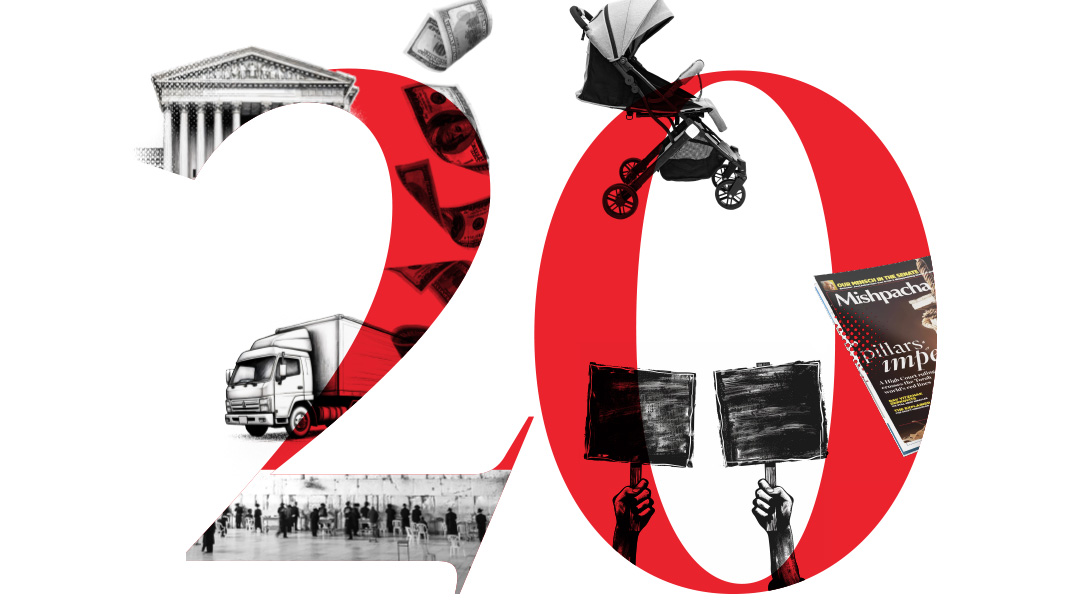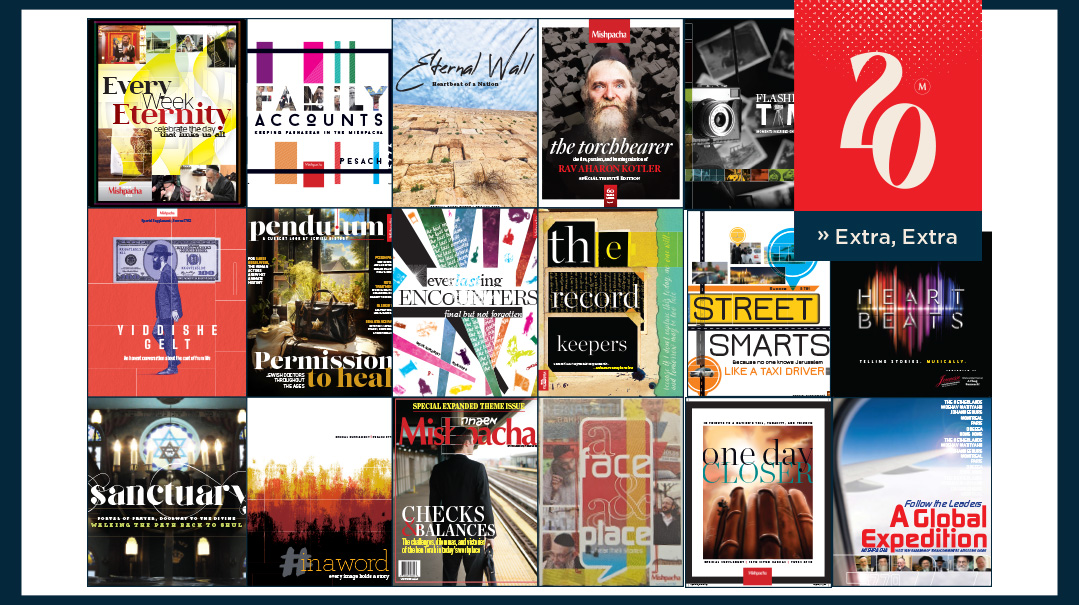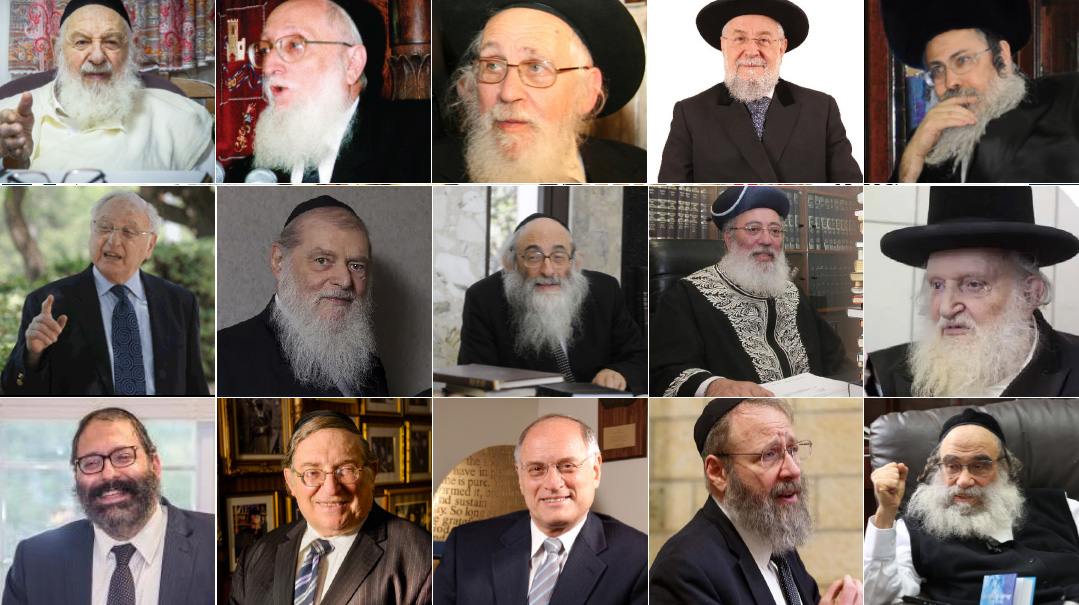20 Turning Points

Twenty contributors share their opinions about the most consequential changes, trends, and developments of the last two decades

During the past 20 years, we’ve brought our readers a consistent weekly package of information, inspiration, education, and connection. But our readership has changed and evolved with the passage of time. The reader of 2024 is not the reader of 2004, and today’s frum world faces a different constellation of challenges and opportunities. What are the most consequential changes, trends, and developments of the last two decades? We asked a panel of 20 contributors at different junctures of the community to share their takes
Slippery Slope
Rabbi Chaim Dovid Zwiebel, Executive Vice President of Agudath Israel of America
E
arly on in my now four decades of service to Agudath Israel, I had occasion several times to warn legislators and judges about “slippery slopes” — how proposed new laws that represented only a slight departure from traditional social norms, and which appeared relatively benign, could lead to further and more radical departures whose consequences could be disastrous for society. Unfortunately, I was proven right.
Over the past 20 years, the slope has become not only more slippery but also steeper. In a case decided in 2003, the Supreme Court overruled its own earlier decision upholding laws that outlaw certain forms of deviant behavior. Little did we know that this case would serve as a turning point in American jurisprudence, and would lead to dramatic erosion in the moral foundations of American society. But that is exactly what happened.
From broadening civil rights protections to changing the very definition of marriage… from tolerating deviant personal behavior to ostracizing religious opponents of deviancy as bigots… from terminating life support for the critically ill to legalizing assisted suicide — all of these “advances” are attributable, at least in part, to the Supreme Court’s determination 21 years ago that notions of traditional morality have no place in the laws of this country.
Though we are Torah Jews with our own moral code, we are still affected by the moral climate of the society around us. The more spiritually toxic the climate, the more we need to insulate ourselves from its noxious fumes. The farther American culture keeps slipping down the slope, the more we need to embrace the counterculture embodied in authentic Torah Judaism.
And therein lies what is perhaps the most important contribution Mishpacha magazine has made to Klal Yisrael over the past two decades: providing a warm hearth around which large segments of the Torah community can huddle to protect themselves from the dangerous social winds and treacherous icy patches all too close to home.
A Million Hours a Month
Yosef Davis, director at Torah Anytime
B
ack in 2006, when the small Torah Anytime team started to record shiurim, technological capabilities were very limited. You couldn’t even rewind or fast forward a video on a digital platform. But there was a realization that things were changing and moving forward; we were on the cusp of something enormous.
Technology can be viewed as a double-edged sword. It wastes valuable time and can lead people astray. Yet it can be used to make Torah learning accessible and available, and we made this our mission. Twenty years ago, a big part of Klal Yisrael believed that the internet was entirely forbidden, the yetzer hara incarnate. Now, there are still communities who limit its usage very strictly, and they are wise in following the call of their gedolim. We would never want anyone to use the Internet if they are not doing so already, but for many of us, it’s become part of our lives. We find ourselves fighting for kedushah and taharah on this unique battlefront, and Torah Anytime fights by harnessing the power of internet to spread Torah.
At this point we’re spreading a million hours of Torah learning a month, creating a virtual yeshivah without walls. People sick in hospital beds and workers at blue collar jobs keep Torah Anytime in their ears all day long. With users across the globe (and since Australia is fourteen hours ahead of EST) there is never a time when someone isn’t learning on Torah Anytime — and the precious gems of shiurim and Torah thoughts are not only available now, but preserved for posterity.
New Megaphones
Rabbi Moshe Hauer, Executive Vice President of the Orthodox Union
T
wenty years ago, English-speaking chareidi Jewry read the Jewish Observer, a magazine published and funded by Agudath Israel that served as a platform to educate and service the community, and project the voices and values of the organization and its gedolim. Its readership was serious and dedicated, its presentation simple, functional, and dominated by text, and its agenda defined by the organization’s vision for the community.
That has since been replaced by Mishpacha and other beautifully designed, visually rich, and commercially successful publications that appeal to the masses by presenting ideological and social issue discussions within a wider menu of human-interest and entertaining content, and include massive amounts of attractive marketing catering to popular religious and material tastes.
The enormous popularity of these publications exerts a soft but very firm power over the community, setting the agenda for social discussions, norms, and lifestyles. The platforms and megaphones of popular columnists and influencers are often more elevated and powerful than those of great gedolim and leaders of the establishment.
This is a radical change and an aspect of the global democratization of mass communication, moving it away from the top-down directive structure of the past to instead be driven by the tastes and interests of readership. While the publications seek to generate meaningful discussions that often pose uncomfortable questions, these discussions are often directly at odds with the other content and marketing that aim to hit the community’s increasingly luxurious and self-reinforcing comfort zone.
In the Torah, the age of 20 represents a higher level of responsibility, especially in serving the community. Reaching this milestone with such resounding success positions Mishpacha to set an elevated agenda for our community, with consistent reflection and action surrounding how every aspect of this powerful platform will be used to make us more deserving of being called a mamleches kohanim v’goy kadosh.
The Demand Is There
Rabbi Gedaliah Zlotowitz, President of ArtScroll/Mesorah Publications
WE
know that every single Yid aspires to “shteig,” to keep growing. But sometimes we can see that the entire nation — Klal Yisrael itself — is shteiging, and from our vantage point, we are privileged to see it very clearly.
Whereas 20 years ago, a great part of our mission statement was to nourish the souls of thirsting Jews with the staples of the Jewish diet — siddur and Chumash, Mishnayos and Gemara — today, we can also invest time and resources in producing works of sophisticated and intricate scholarship, knowing that the thirst is there.
With credit to so many amazing global programs like Oraysa, Dirshu, Zichru, and to the Agudah and OU putting harbatzas Torah at the top of their agendas, we know that our Torah scholars can continue to immerse themselves in projects like Tosafos, Minchas Chinuch, or yet another dimension of pshat in Rashi on Chumash: The demand is there!
As the navi foretold, “V’chol banayich limudei Hashem, And all your children will be students of Hashem.” May we merit seeing the conclusion of that pasuk — “v’rav shelom banayich, and your children’s peace will be abundant.”
Left Abandoned
Shlomo Soroka, Director of Government Affairs at Agudath Israel of Illinois
After a recent meeting in Illinois’s State Capitol, I bumped into a non-Jewish Democratic legislator who was burning the midnight oil. While we chatted for a few moments in the virtually empty building, he asked me why we’re seeing an explosion of anti-Semitism coming from the American far left, including from some progressives in his own party. Wasn’t anti-Semitism the “domain of the far-right white nationalists?”
I thought for a moment as dozens of other conversations with Jewish progressives flashed through my mind, and then it hit me.
History repeats itself. The only question is if we are willing to learn its painful lessons. Anti-Semitism, with all the torment, death, and destruction it has wrought upon us, is one of Hashem’s methods of ensuring we never acculturate and assimilate into oblivion. We can’t flee our identity or sacred destiny no matter how hard we try. And so, vile Jew-hatred often originates in the very same time, place, and social arena where Jews have been phenomenally successful at acclimating, and achieving financial, academic, and political success.
Only after we became powerful and comfortable in ancient Egypt did Pharaoh decide to enslave us. Only after we participated in the grand banquet of Achashveirosh did Hashem empower Haman. Only after Hellenism became rampant did the Assyrian Greeks attempt to eradicate the Torah and its observance. The Spanish Inquisition began in the twilight of the Golden Age of Spain where Jews were at the pinnacle of political power and led the empire in contributions to its financial, cultural, and geopolitical development. And pre-World War II Germany was the epicenter of Jewish success in every secular realm. That’s where the hate begins — but not where it ends. The flame of contempt morphs into an uncontrollable conflagration that consumes communities indiscriminately. Every time we feel at home, every time we think we’ve finally made it and have been accepted as one of them, they remind us that we are different.
There’s no precedent for the level of freedoms we Jews enjoy in America. The levels of assimilation and attrition are also unprecedented. And the reality is that most American Jews identify with the liberal and progressive movements. (Not all progressives are anti-Semites, but anti-Israel policy positions have become part of the movement’s platform and anti-Semitic rhetoric is often tolerated in those circles.)
That’s why many of our progressive brethren feel so hurt, betrayed, and confused. Most Jewish lawmakers I know have left their respective progressive caucuses. But few have the clarity to identify where they will go next. Jewish activists who gave their lives for progressive causes are in agonizing limbo. Who is reaching out to them with support and guidance?
We are at an inflection point in history. Will we internalize the lessons of the past before it’s too late? We, the Jewish people, hold the keys to our future. Hopefully we will choose the key that opens the door to the ultimate Geulah.
Apart But Still a Part
Yonoson Rosenblum
T
he most significant long-range trend of recent decades, in my opinion, is the changing nature of Israel’s chareidi community.
The young men who rallied to the banner of the Chazon Ish were a self-selected group characterized by a high degree of idealism and mesirus nefesh for Torah, as well as by almost uniformly great abilities. As a small, beleaguered minority, they adopted an attitude of societal isolation to protect the flame within.
We are now three and, in some cases, four generations removed from those days, when there were one or two kollelim in Jerusalem, and the same in Bnei Brak. The chareidi community has grown by leaps and bounds. Thirty percent of entering first-graders in Israel are in chareidi frameworks, and chareidim are close to 15 percent of the Israeli population.
That much larger tzibbur is not the community of the 50s writ large, but something far different. Like any large community, it encompasses those of various levels of commitment and capabilities. And its members are no longer choosing a path against the grain, but following a well-trod path for which they may or may not be well-suited.
The implications of this rapid, and unexpected, growth are many. I’ll mention two. As a large and ever-growing percentage of the overall Israeli population, we cannot expect to be ignored, like a small group of Amish farmers in Wisconsin.
At the same time, as a major segment of the population, the chareidi community has more responsibility for its fellow Jews in Israel, and that is recognized by much of the community, which seeks both to remain fully chareidi in conduct and belief in the primacy of Torah, and to be part of the larger general society.
Before the Crisis Hits
Rabbi Sendy Ornstein, President of Relief Resources and Renewal
T
wenty-one years ago I went to rabbanim and psychotherapists, shared my dream of founding a referral organization for mental health. The overwhelming response: “Stick to your day job. No self-respecting frum Jew will call a mental health hotline.”
We opened anyway, and there were calls. Maybe 40 a month. And now? Four hundred a day. So yes, Klal Yisrael is bigger today, definitely, but Klal Yisrael has also become much more aware.
The calls we got back then often regarded mental health crises. Today, baruch Hashem, people are not waiting for a crisis to happen — they are calling for referrals to treat conditions earlier on and avoid spiraling into crisis.
New on the scene in the past 20 years, social media has caused a lot of challenges. Through this medium, addictions to internet, alcohol, drugs, and online gambling have multiplied. Beyond that, life in general has become harder and faster, and many, or maybe even most people, are struggling to keep up with financial and social pressures, with European and UK communities slower than the American fast lane, but also picking up speed.
Life used to be simpler, with jobs from nine to five and more time spent with family. Now, most couples have three jobs between them. You have to battle just to get your kids into school, yeshivah, and camp, and the combination of all these pressures and factors brings us more anxiety, depression, and OCD.
People trust us now, and they are ready to face mental health problems. They no longer want to be treated by just any psychiatrist on their insurance company’s list, but look for the best quality care. And long gone are the days when you couldn’t tell your parents, family, or rebbi that you were going for therapy or treatment. Mental health has become a priority, and we’ve come a long, long, way.
That is not the only heartening development I’ve been privileged to be part of. Eighteen years ago, we put an ad in the frum newspapers, seeking a donor for a young mother who needed a kidney transplant. Twenty-five people responded. Nowadays, when a kidney donor drive is held, 150 people show up. Kidney donation has become something that frum people do. Renewal, the organization we formed to facilitate donations, now averages ten kidney transplants a month.
The transplant remains a major surgery, of course, but it is recognized as safe and doable. Kidney donation is accepted and recognized across the community, with chassidish, yeshivish, Sephardic, and Modern Orthodox would-be donors volunteering to be tested and donate. Today the frum community is responsible for a phenomenal 20 percent of all altruistic living kidney donations in the United States, meaning those that come from strangers rather than family and friends of the patient. We are helping a lot of medical centers and universities to replicate the Renewal model.
Eighteen years after that first desperate ad, almost every frum Jew knows someone who’s given away a kidney, and that’s something we can all be proud of.
A Different Read
Shoshana Friedman
T
wenty years ago, when Mishpacha first appeared on the newsstands, reading meant the tactile experience of touching paper and turning pages. Today, much of the world – and much of our frum world – does their reading on screens. It sounds like a purely technical change, but it’s so much more than that.
Mishpacha’s success is testament to the fact that in our corner of humanity, print is here to stay. On the surface, that’s because of Shabbos – but it’s also because our people still love an immersive reading experience, still have an attention span, and still value quality writing. That said, many parts of the magazine are structured differently than they were 20 years ago, because many of our readers seek something different in their reading experience.
We’ve brought in many punchier, interactive formats. We use shorter paragraphs and think about the interaction between visuals and text. It’s no longer considered a breach of professionalism for the writer to have an active presence in a piece (or, as one of our classically trained journalists puts it, to use the word “I”). We think a lot about authenticity in dialogue (would a high school girl say “so sweet” or “heaven”?) and aim for experiential writing (set the scene, bring the reader into the room with you).
Like all communicators, we’re straddling that fine balance: sharing something of value in a medium that meets the readers where they are.
Unexpected Targets
Avi Schick, President of the Rabbi Jacob Joseph School
M
ore than a decade ago, the New York City Health Department enacted a regulation of metzitzah b’peh. It was the first regulation of bris milah ever enacted in the United States. A broad coalition that included Satmar, Chabad, and the yeshivah community banded together to challenge the City’s regulation, and prevailed.
That pattern has unfortunately repeated itself in the ensuing decade. Since the attempt to regulate milah, New York has targeted other aspects of our religious life. Government rules have singled out our shuls and our yeshivos. What would have been unthinkable a few decades ago has now become almost routine.
Thankfully, we also learned lessons from the battle over metzitzah b’peh, and successfully challenged the government’s hostility toward shuls and yeshivos. We have learned that when we work together, b’achdus, we can achieve unusual success. As we move forward, we may find ourselves repeatedly reminded of the eternal lesson taught in Pirkei Avos: “Hevu zehirin b’rashus — be wary in your dealings with the governing powers, [for they only befriend a person for their own benefit.]”
Deepened Connection
Aliza Bulow, Founding Director of Core
T
hirty-five years ago, as a young mother, I wished I could learn more Torah. I was fortunate to live near some wonderful teachers, but classes were just once a week. I had time to read and listen, so I subscribed to tapes sent by mail and read all the books I could. But there wasn’t enough. I wanted even more, and I knew I was not the only one.
In 2001, FreeConferenceCall.com was born, and with it, the world of easy access to continuing Jewish education for women. Women around the world could now pick up the phone to hear classes on parenting, marriage, mussar, shemiras halashon, Tanach, stories, and chizuk. We could even ask questions! The best teachers in the world could now teach in any community and women began to take advantage. Torah started to infuse our adulthoods.
As Internet access grew, more and more classes were recorded and posted online. TorahAnytime, founded 18 years ago, now posts 1,000 shiurim a week! Over the past two decades wide-ranging, high-level learning has become a regular part of the lives of frum women.
All of this access has changed the way women engage: with the Torah, with each other, with their communities, and even with their husbands. Women ask more questions, understand answers on a deeper level, and share more Torah with their families and friends. Women who learn more build stronger homes.
Sarah Schenirer understood that. She wanted to ensure that families would be founded on Torah by educating the girls who would become the mothers of those families. Sarah’s spark is still glowing in the hearts of those mothers as they tap into the wonderful resources now available and continue to deepen their connection to Torah into their adult years.
Yearning for Rebbe Nachman
Rabbi Chaim Kramer, Founder, Breslov Research Institute
Since the passing of Rebbe Nachman in 1810, Breslover chassidim exhibited tremendous mesirus nefesh to get there, even braving the dangers of the Bolshevik and Stalinist eras to make the trip.
When the gates of Russia opened with glasnost, the waves of Breslover chassidim coming to Uman grew with each passing year, until it became a worldwide movement. Through Covid until today, with the ongoing war in Ukraine, the site continues to attract Jews of every denomination — not necessarily “card-carrying” Breslovers — all year round, but especially on Rosh Hashanah.
Rebbe Nachman said: “There will come a time when people will yearn very much for me (and my teachings).” This time has arrived.
Five years ago, 45,000 people arrived in Uman for Rosh Hashanah. Last year, approximately 35,000 made the trip — and this during wartime! As most Jews around the world focus on Pesach, the tilapia for the upcoming Rosh Hashanah is being processed and flash-frozen to be shipped to Ukraine.
The many, many thousands who have begun studying Rebbe Nachman’s writings have started a spiritual revolution that extends all over the world. Even more so, his promise to take the person out of Gehinnom if they visit his gravesite, has encouraged untold numbers to change their lives for the better.
During the last few decades, Uman has become a world-famous magnet, attracting all who seek to find their inner selves and improve their lifestyles, to attain a satisfying life and an inner, tranquil peace.
The Numbers Game
Rabbi Jonathan Guttentag, Principal of Whitefield Community Kollel, Chairman of Eretz Hakodesh UK
T
hroughout history, Jewish populations have remained remarkably low in comparison to the world total. In Mark Twain’s oft-quoted words (1898): “If the statistics are right, the Jews constitute but one quarter of one percent of the human race. It suggests a nebulous puff of star dust lost in the blaze of the Milky Way.”
Inside the Jewish people, too, strictly Orthodox Jews were long a vanishing small percentage, a nebulous puff of black star dust, as it were, of die-hard religious adherents, outshone and vastly outnumbered by the blaze of a societally successful, secular, and assimilating mainstream.
Not anymore, however. Take a drive around the frum communities of Gateshead and Manchester. Streets that were formerly mezuzah-free and often frankly unsafe have now become part of an expanded frum community. The bulging portfolio of weekly simchahs in the frum community is clear evidence of a significant demographic boom. Here’s the latest headline from the formerly doom-predicting general Jewish press: Charedi population to rise to 40 percent of Anglo Jewry by 2040.
With that rise comes a challenge. Having found the elixir of successful Jewish growth — the eternal truth that communities and individuals whose lives are based on dedication to Torah learning, personal and institutional, will prosper and grow — do we have the wisdom, insight, and determination to reach out to our brothers and sisters who do not share the riches of a Torah background and life that we take for granted? Do we realize that we have the responsibility and the access to resources that could make a difference to so many?
It’s up to us to play our part in bringing Torah to the masses. Let’s do it! We each have our part to play.
Growth Spurt
Rabbi Moshe Friedman, Director at Kollel of Houston
E
veryone knows that over the last 20 years, Lakewood has been transformed from a small, quiet town into the biggest Torah community in North America. Less well known, however, is that during that same period, and especially over the past decade, several “out-of-town” communities have gone through metamorphoses of their own.
Cities like Chicago, Cleveland, Detroit, Miami/Boca, and Houston are entirely changed. What were once small frum communities are now home to hundreds if not thousands of Torahdig families.
The infrastructure of these cities is both fueling and growing along with the expansion. New kollellim, proper mosdos chinuch, and shuls are sprouting. Hatzalah, Agudah offices, and Chaveirim branches are all standard. Frum-owned businesses are the base for many job opportunities. Kosher groceries, restaurants, and other frum amenities are making it much easier to live in these beautiful communities than in the past.
Along with the growth comes the challenge of maintaining the small-town vibe and the accompanying advantages. As always, balance is key in sustainable success, and in many of these communities the balance has been achieved, resulting in a new breed of hybrid “in-town out-of-town” communities.
They All Want the Same Thing
Meir Levi, veteran shadchan
AS Klal Yisrael has grown, we have seen major changes to the shidduch process – but boys and girls have been affected differently.
The boys now have so many names to choose from, and it’s overwhelming. It’s a good challenge to have, but a challenge all the same. Not only that, it’s difficult to differentiate one girl from another. It’s a neis when a mother of a boy will take up my suggestion from the over-100 other names she’s been given.
When it comes to girls, I find that they have become much more homogenous. Many more girls want a “metzuyan” than in the past. Sometimes it feels like they all want the same guy!
I spoke to a group of girls lately. They are all wonderful, and they all seem to want the same exact thing. The reality is that not all of them will end up marrying The. Top. Boy.
Why, then, are so many girls looking for that same small slice of the pie? I think it may be because in general, girls want to conform to expectations. And during these two decades, society has continuously refined those expectations. This is what they’re taught to want.
Twenty years ago, not every girl wanted the top learner; not every girl needed it. Honestly, not every girl needs it now either – but more seem to want it, and feel they deserve or need it. After all, they are such good girls! What they don’t always realize is that it’s harder to be a “good boy” than it is to be a “good girl.” A good girl runs chessed program or is G.O. head or something like that. A good boy needs to be much more than that.
Another factor that makes shidduchim more difficult today is the lack of shadchanim. Our numbers have increased, but the number of shadchanim hasn’t kept up with the growth. That’s why I started “Newly Reds,” as a way to mobilize the masses. Our official shadchanim can’t keep up — everyone needs to be a shadchan!
Child-Pleasing Parents
Sara Eisemann, LMSW
F
rom my vantage point, it seems that parenting has undergone a major shift during the last two decades. Some might even argue that it has veered off course.
Two generations ago, the children of Holocaust survivors set out to raise a generation that would perpetuate the legacy they’d inherited from their survivor parents. That generation of survivors’ children absorbed the guilt and heavy responsibility of mending their parents’ gaping wounds, and attempted to pass it on to their own children. But the diluted version, being one generation away from the horror, was not strong enough to be accepted unequivocally. Those children began to question the mission; they also wondered where/if their own needs came into the picture. And they determined to do things differently when it came time to parent their own children.
The result is a generation of parents who often overcompensate with attachment and a focus on the child’s happiness. These parents understand that guilt alone is not enough of a motivator and that children need a positive buy-in. They’ve placed their eggs in the attachment basket and hope that creating strong connections with their children will keep them close, to both family and our mesorah.
As a therapist, I’m watching the fallout of this extreme child-centered version of parenting. Clients share, with irony, that they’ve gone from pleasing their parents to pleasing their children. It may fall on this generation to find the balance between hyper-attunement and resilience.
Talking the Talk
Yisroel Besser
A
few years ago, someone showed me a paper on which Rabbi David Abuchatzeira had written a question, asking what the unique mitzvah of this generation is. At a public event, he had passed it to Rav Aharon Leib Steinman, who wrote back a one-word answer.
“Emunah.”
I’m not sure I understand the practical applications of the answer, but on a street level, the signs are everywhere: in what people read, in what inspires them, and even in the lyrics we sing.
Commenting on the pasuk of Gam ki eileich… lo ira ra ki Atah imadi, Rav Tzaddok HaKohein of Lublin notes that the perek suddenly shifts from discussing Hashem in lashon nistar, third person (yarbitzeni, yenahaleini, yancheini), to lashon nochach, addressing Him directly: ki Atah imadi. Because when a person is b’gei tzalmaves, in a place of danger or darkness, they can suddenly see the Ribbono shel Olam’s presence more clearly.
Over the last few years people want to talk about Him, and they want to talk to Him. I was at a chasunah recently and the band was playing “Fahr Dir.” A friend tapped me on the shoulder and indicated the small crowd of people standing and swaying around the singer: not just teenage boys, but men — rebbeim, accountants, people with big health care portfolios, and people with big credit card debt — with their eyes closed, some of them with their hands outstretched, singing along.
The masters of hisbodedus, whether from the world of chassidus or of mussar, taught that a person has to learn to talk to the Ribbono shel Olam as to a dear friend, to unburden and share and let the words flow. The Chofetz Chaim would go into his private room, from where he was heard conversing with his Creator.
It’s a noisy world — the conditions less than ripe for classic hisbodedus — but somehow, it’s precisely through the commotion that we have learned to talk to Him.
Bringing Them Home
Rabbi David Markowitz, Executive Vice President of Olami
O
ver the past two decades, the landscape of kiruv in the United States has undergone a profound evolution, transforming from a niche pursuit into a vibrant tapestry woven into the fabric of the frum community. What was once a mission to reach out to individuals like the stereotypical “ponytail guy” who wandered into shul, has now expanded into a network of over 100 kiruv organizations within the Olami network alone. From the pioneering efforts of college and young professional organizations like Meor, Emet, RAJE, and Aish HaTorah, to the outreach beyond college and young professional circles with NCSY, Oorah, Project Inspire, and so many more, kiruv has become a multifaceted endeavor touching all corners of Jewish life.
This growth is not just anecdotal; it is reflected in the numbers. Two decades ago, there were only a handful of individuals working in kiruv on college campuses. Today, within Olami’s network alone, there are 368 full- and part-time educators dedicated to campus and young professional communities.
The impact is staggering: Over 20,000 participants who are 18-30 years old engage in kiruv programs annually in North America, with over 1,000 of them making the profound decision to begin observing Shabbos and dedicating substantial time to learning in yeshivah and seminary settings each year.
The other significant change is the direction of engagement. Twenty years ago, it was the searchers who were making the first move, showing up in kiruv settings and finding their way back to Torah and mitzvos. Many had grown up Conservative, gone to a Jewish summer camp, and were familiar with basics of Judaism and Jewish holidays.
Today the students are increasingly more assimilated — it’s currently the norm to have a non-Jewish parent and never to have attended a Pesach Seder. So it has fallen to the incredible educators to engage the most secular of Jews and expose them to a world of Judaism that the students never knew existed.
While the challenges of reaching and engaging more assimilated Jewish students abound, the openness and interest of those who show up is much higher than ever before. There is an excitement, freshness, and enthusiasm that comes from students who had no previous exposure to a Torah lifestyle that leads to a remarkable number of them taking that inspiration into action and committing to a life of Torah and mitzvos. The resulting influx of baalei teshuvah has not only enriched our communities but also revitalized them, injecting new energy and passion for Torah and mitzvos.
On Their Own Two Feet
Shmuli Margulies, Chairman and Cofounder of Mesila
When I was growing up, parents worked hard, saved hard, davened hard, and somehow managed to marry off their children; maybe five to ten percent of our community received financial aid when making a chasunah. Today, in the communities I am involved with worldwide, that number is probably closer to a whopping 90 percent.
I was zocheh to hear from Rav Wosner ztz”l that not since Matan Torah has there been so much tzedakah v’chesed in the world. But as we are all well aware, there are never enough funds to meet the growing needs despite the abundance of Chinese auctions, dinners, crowdfunding appeals, and the potpourri of “-a-thons” — walk-a-thons, shteig-a-thons, marathons, Shas-a-thons, phone-a-thons — that fill our schedules.
With the increase in tzedakah funds distributed, there’s a corresponding increase in reliance and dependency. Too many people in our communities still find their finances spiraling out of control despite (dare I say because of?) the growing amounts of tzedakah being raised and distributed over the past 20 years.
In recognition of this issue, numerous organizations have in recent years begun guiding families toward achieving financial independence. We at Mesila have worked on many fronts to facilitate sustainable, long-term financial improvement, and we have definitely found an increased awareness and openness among today’s young families and business owners to go beyond their comfort zones and get helped.
Those who courageously take the step forward to be coached, experience life-changing improvements — not only in their finances — but also in their shalom bayis, upbringing of children, simchas hachayim, physical and emotional health, and so much more.
(Originally featured in Mishpacha, Issue 1008)
Oops! We could not locate your form.







